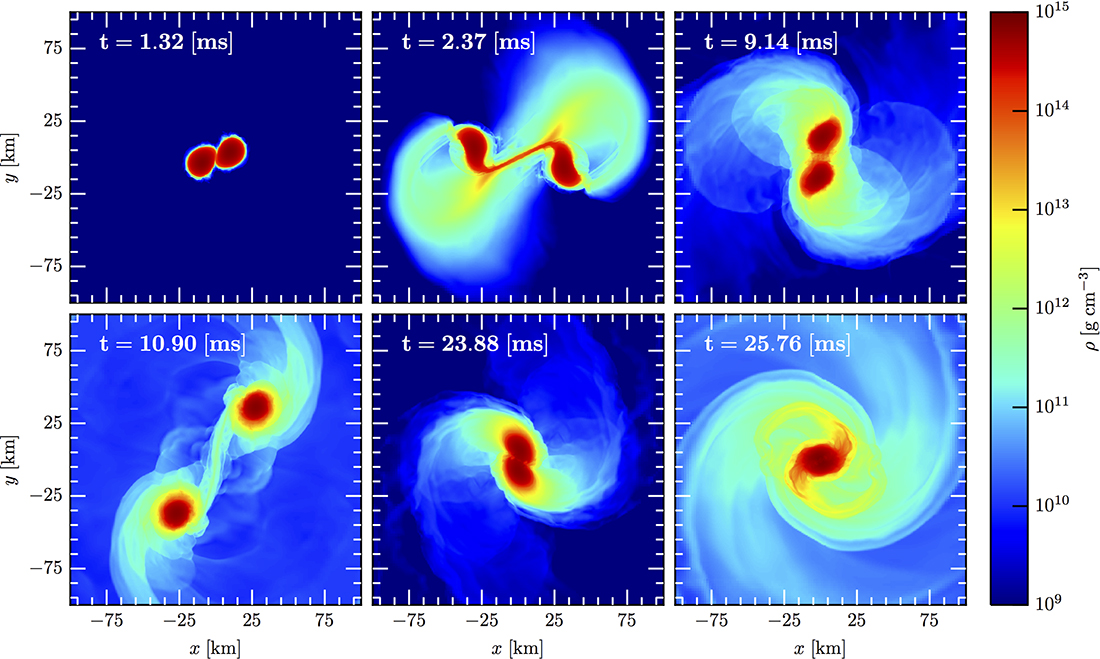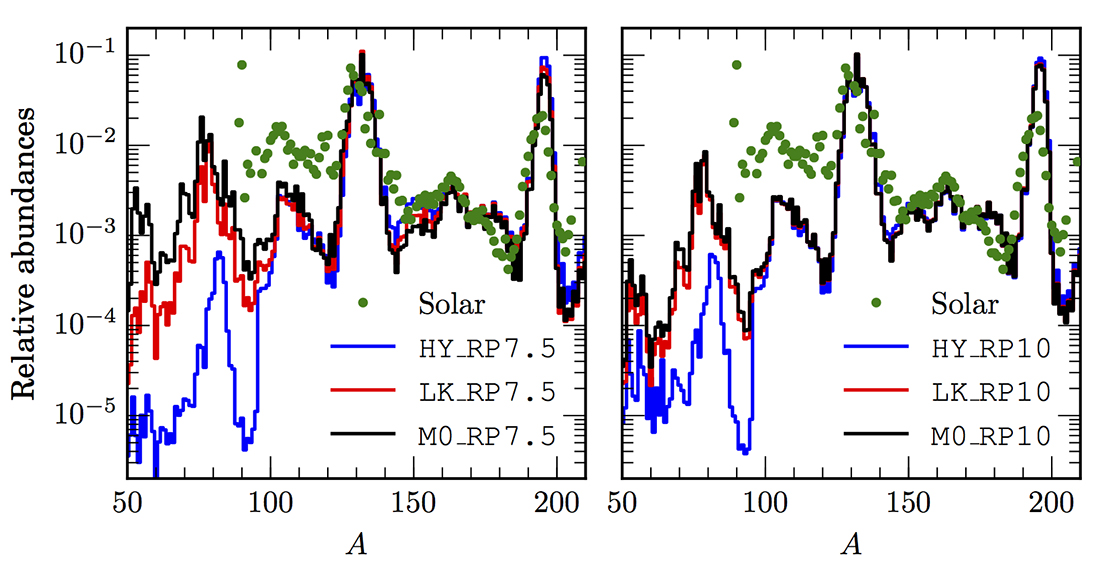ASTROPHYSICS
Unveiling the Equation of State of Nuclear Matter with Binary Neutron Stars
Principal Investigator:
Filippo Galeazzi, Luciano Rezzolla
Affiliation:
Institute for Theoretical Physics, Goethe University Frankfurt (Germany)
Local Project ID:
pr48fa
HPC Platform used:
SuperMUC of LRZ
Date published:
Leveraging the HPC infrastructure of LRZ, researchers at the Goethe University in Frankfurt/Main employ a series of in-house developed cutting-edge numerical methods to simulate in full general relativity the inspiral, merger, and collapse of neutron stars. The computationally intense, fully parallel simulations incorporate relativistic hydrodynamics, nuclear finite-temperature equations of state, and an approximate treatment of neutrino emission and absorption. The results, obtained by measuring gravitational waves, can provide important information on the properties of matter at nuclear densities.
Introduction
2015 marked the hundredth anniversary of Albert Einstein’s lecture at the Prussian Academy of Science in which he introduced, for the first time, the famous field equations which became the core of his theory of general relativity.
This masterpiece of 20th century science has proven to be extremely solid in all its predictions, from the precession of the perihelion of Mercury, to the observation of gravitational lensing in distant galaxies, to the more mundane time-delay corrections required by the global positioning system. One last piece of the puzzle is still missing, though—the direct measurement of the gravitational wave (GW) radiation emitted by any accelerating mass. These ripples in the spacetime fabric are extremely weak even when produced in the most extreme conditions, such as those present during the mergers of two black holes or neutron stars. For this reason they have eluded experimental scientists for almost four decades. But things are about to change.
Recently, a new array of advanced gravitational wave detectors—Advanced LIGO and Virgo—came online and are expected to observe up to 40 events per year involving the mergers of two compact objects. Despite the high sensitivity of this generation of ground base interferometers, however, it is still necessary to use accurate gravitational waveform models to extract information from the signal produced by the detector.
In this project the researchers at the Institute for Theoretical Physics at Goethe University Frankfurt focus on the merger of two neutron stars orbiting together in a binary system. The nonlinear nature of the Einstein equations, coupled with the complex microphysics behind neutron star matter, requires the use of sophisticated codes incorporating advanced numerical techniques to produce accurate results. By using the GW signals calculated in their numerical simulations the scientists will be able to strongly link the properties of neutron star matter to a precise set of observable frequencies from the detector [1]. This information, together with the electromagnetic counterparts of these events, will shed some light on the engine that powers short gamma ray bursts.
The properties of matter at the ultrahigh densities and low temperatures reached inside neutron stars cannot be observed in a conventional laboratory on Earth. In this context, accurate GW astronomy presents a unique opportunity to constrain current knowledge of the equation of state that describes these regimes. But GWs are not the only observables that can be linked to the equation of state of neutron star matter. During the violent merger of two neutron stars, a large amount of neutron-rich material is ejected, leading to the creation of heavy elements. While undergoing radioactive decay, these elements emit in near-infrared and optical bands of the electromagnetic spectrum. The characteristics of these emissions are strongly affected by the composition, temperature, and total mass of the dynamically ejected materialFor this reason the researchers have developed a series of cutting-edge methods to simulate in full general relativity the inspiral, merger, and collapse of neutron stars. Their approach incorporates relativistic hydrodynamics, nuclear finite-temperature equations of state, and an approximate treatment of neutrino emission and absorption. Such simulations require the use of computational facilities such as the LRZ, where the scientists make use of thousands of CPUs every week, producing several terabytes of data. This data is processed in situ at the LRZ facility and, for a more detailed analysis, is transferred to the team's local cluster in Frankfurt am Main (LOEWE).
Projects and results
The code used for the simulations is based on the CACTUS computational toolkit, which provides an efficient infrastructure for large-scale simulations, including MPI and OpenMP parallelization, adaptive mesh refinement, and memory and output management. The general relativistic field equations are integrated using the McLachlan module from the Einstein Toolkit, which is based on high-order, finite differencing methods. The general relativistic hydrodynamic equations are solved by WhiskyTHC, which employs a high-order, finite-difference, high-resolution shock-capturing method; this allowed the researchers to achieve third-order convergence during the inspiral of a binary neutron star system. WhiskyTHC also implements a sophisticated treatment of neutrino interactions that takes into account both the cooling and the absorption on the thick and hot neutron star matter.
In total, the scientists used 10 million core hours on LRZ's SuperMUC HPC system to simulate binary neutron star mergers, investigating both quasi-circular and eccentric orbits and using several equations of state.
Binary neutron star collisions
The researchers simulated the inspiral and merger of binary neutron star configurations with 5 different values of the initial periastron radius, using a nuclear equation of state to describe the properties of matter at high densities. An example of one of these encounters is shown in Fig. 1.

Figure 1: Snapshots of a binary neutron star collisions with an initial periastron of 14 km, from late inspiral (top left), touching (top right), merging (bottom left) to the formation of a metastable hyper-massive neutron star (bottom right). The colours represent the mass density in the orbital plane.
Copyright: Institute for Theoretical Physics, Goethe University Frankfurt (Germany)R-process nucleosynthesis from the ejecta
The most striking feature of binary neutron star collisions is the amount of material that is ejected. It reaches the value of approximately one-tenth of a solar mass. By comparison, a similar binary in quasi-circular orbit can produce 20 times less ejected material. The ejected material is extremely neutron-rich and is thought to be responsible for the production of a large portion of the elements in the Universe heavier than iron. This process, know as r-process nucleosynthesis (rapid), requires a high neutron fraction environment, which allows an efficient neutron capture on the heavy seed nuclei. This work analyses in great detail the effects not only of different orbital parameters in the production of r-process nuclei from the ejecta but also of different neutrino treatments. The researchers have included the effects of neutrino cooling into their merger simulations and also of neutrino absorption onto the hot ejected material. Fig. 2 shows the results of the r-process nucleosynthesis calculations for different models that are included in a series of publications on the topic [2].

Figure 2: R-process nucleosynthesis produced by the ejected material of binary neutron star collisions, with periastron radius of 11 km (on the left) and 14 km (on the right). Different neutrino treatments are presented.
Copyright: Institute for Theoretical Physics, Goethe University Frankfurt (Germany)References and Links
[1] “Spectral properties of the post-merger gravitational-wave signal from binary neutron stars” K. Takami, L. Rezzolla, L. Baiotti, 2015, PRD, 91, 064001
[2] “Dynamical Mass Ejection from Binary Neutron Star Mergers” D. Radice, F. Galeazzi, J. Lippuner and L. F. Roberts, C. D. Ott and L. Rezzolla 2016, arXiv:1601.02426 (Monthly Notices of the Royal Astronomical Society, Volume 460, Issue 3, 11 August 2016, Pages 3255–3271, https://doi.org/10.1093/mnras/stw1227)
Scientific Contact:
Prof. Dr. Luciano Rezzolla
Theoretical Astrophysics
Institute of Theoretical Physics
Goethe University Frankfurt
Max-von-Laue-Str. 1, D-60438 Frankfurt am Main (Germany)
e-mail: rezzolla [@] th.physik.uni-frankfurt.de